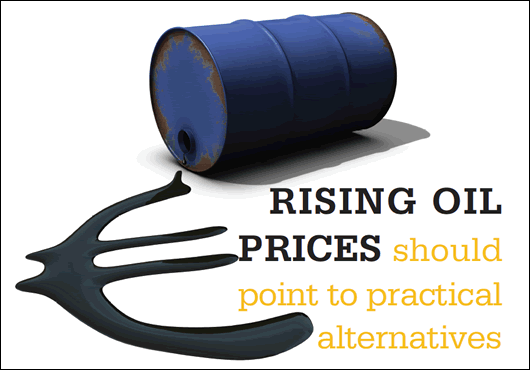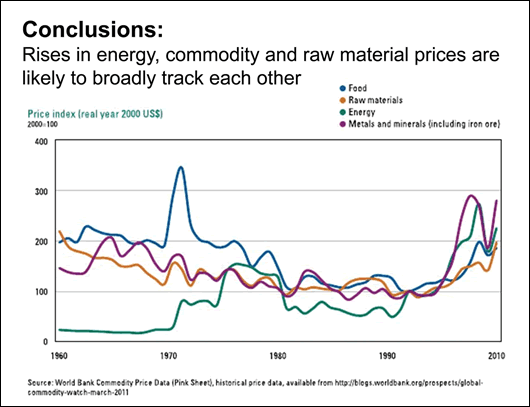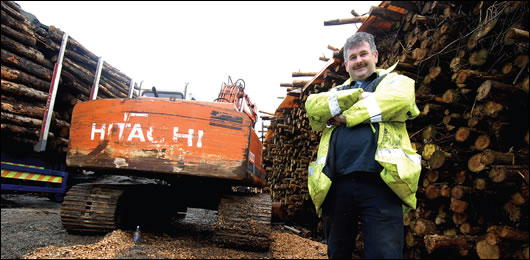- Oil Peak
- Posted
Oil alternatives

With oil prices remaining at ominously high levels in spite of sluggish economic growth figures and efforts by the International Energy Agency to release additional capacity, Ireland must act fast to cut oil usage. Why then, has the government withdrawn grants for renewables while continuing to subsidise oil and gas boilers?The average household needs to find an additional €950 during 2011 to cover energy bills as higher oil prices are passed on by wholesalers and retailers. But must the steady rise in oil prices really have such stark implications for every home? And what should government be doing about it?
Having averaged $85 a barrel over the course of 2010, oil is now trading at $110 to $115 a barrel. In 2010 Ireland spent €4bn importing oil. This equates to a somewhat crude average of €1,000 for every man, women and child, irrespective of age and income – and the comparable figure for 2011 is likely to be around €1,350.
With an average of 2.7 occupants per home, the additional burden placed on a household due to higher oil costs is €950. (While the margin charged by home heating oil companies and others is excluded from the €4bn bill, the margin of resellers is unlikely to have changed much over the past year, and so the €950 figure holds.)
The government is giving the matter little enough attention. First, government is guided to a great extent by the policy assessments of the Economic and Social Research Institute (ESRI). Sadly, the ESRI has been slow to acknowledge the link between oil costs and economic activity, and take the next logical step – highlight what can be done on a practical level to stop money leaving the country to buy oil, and circulate it within the local economy instead. (For the wider implications of rising oil prices see the accompanying graphs. Again, government-supported economists appear slow to tease out the issues here.)
Accounting firm Ernst & Young has a much better handle on the interaction between economic activity and oil cost, pointing out in February of this year that the Irish economy would shrink if oil prices remained in or around $120 a barrel. The latest figures from Ernst & Young, released at the end of May, say Ireland’s economy will contract by 2.3% in 2011, with consumer spending falling 4% over the course of the year.1
Households, including our 15% unemployed, are already struggling with other outgoings. The pressure from mortgages (790,000 of Ireland’s 1.4m homes are mortgaged) and taxes is only being compounded by rising oil prices.
Oil prices are likely to rise 30% over the next three years – that’s according to Fatih Birol, chief economist to the International Energy Agency (IEA), in an interview with Australian media at the end of April. The IEA’s track record has been to downplay concerns regarding rising oil prices, which makes Birol’s projection all the more prescient. Translated into prices at the pumps, the IEA forecast, if correct, would see the cost of a litre of fuel approach €2 within three years, up from €1.45 now.

Oil prices are likely to rise 30% over the next three years, according to IEA chief economist Fatih Birol
In early June, RTE reported that higher petrol and diesel bills would add €400 to the motoring bill of the average family in 2011. The figures drew on data compiled by AA Ireland, suggesting that the average family has gone from paying €165 a month on motor fuel in late 2010 to around €230 a month in 2011.
The key point, however, is that some households are much more exposed than others. A small urban home with low car reliance may be relatively unscathed. At the other end of the spectrum large rural homes with high car dependency are hurting most.
Little can be done fast to change travel habits to ease back on oil use. Transport initiatives – the promotion of walking and cycling, public transport investment, and intervention in schools and workplaces – will take time to pay dividends, and initial progress may only be partial, especially in households ‘locked in’ to long-distance car-commuting by being too remote to even examine public transport alternatives.
Home insulation and home heating offer far more scope. Insulation is being addressed but there are shortcomings. The Warmer Homes scheme is aimed at households with no or low incomes. While it is a good programme it is confined to ‘entry level’ interventions – attic insulation, lagging water pipes, tanks and cylinders, draught proofing windows and doors, pumping cavity walls and offering advice to reduce consumption.
Fuel poverty, the spending of 10 per cent or more of household income to adequately warm a home, is rising. Oil delivery companies have slashed their minimum delivery amounts to as little as 200 litres, and worse, some petrol stations are now selling home heating oil to customers carrying it away in 5 gallon cans. With higher charges typically imposed for smaller quantities, the all-too-common scenario where the person with least ability to afford energy has to pay the most for it is becoming more common.
The Better Energy programme – introduced in May to replace the Greener Homes scheme and Home Energy Saving scheme – tends to cater for higher earners who can afford to pay around 70% of the total cost of the energy-saving enhancements. Middle-income families are often worse off than low-income households, because they can’t avail of the Warmer Homes scheme on the one hand, but can’t afford to upgrade on the other. Additional measures will be needed here.
And there are ways out. The sections below – on wood energy, heating controls, heat pumps and solar – give some insights into what can be done, building envelope aside. Ireland won’t be able to staunch oil price rise. But by minimising its use we can stimulate local economies and foster reliance.

The prospects of converging high energy, commodity and raw material prices underline the need to cut energy consumption
Wood energy
Grant funding was withdrawn from wood boilers under the Better Energy Homes initiative announced on 11 May. No explanation was given. And more curiously, grants were retained for new oil and gas boilers – albeit high efficiency boilers, subject to being installed with heating controls.
When it was introduced, the SEAI grant did not cover log-burning stoves – just wood chip and wood pellet models. The downside with stoves that use processed wood feedstock is that the price of wood pellets and chips tends to track the price of oil, limiting the benefit of moving away from fossil fuels in the first place. But there has been a shortcoming in relying on cut logs also: getting a steady supply of seasoned local sawn timber has proved problematic for some wood-burning households. For commercial wood boilers the moisture content of the timber has to be brought down to around 30% before it is chipped. For household use the moisture content has to be brought lower still, to 16 to 25%, with 20% being a good average, according to Michael Stack of Waterford Stanley. And because they tend to spark more, soft woods, such as thinnings from sitka spruce plantations, are better burned in a closed stove. Higher quantities of soft wood are needed to achieve the same heat output due to its lower bulk density.
To reduce moisture content sawn logs need to be stacked outdoors for around two years. The stack should be stored under a waterproof but breathable cover, with the cut ends facing southwest so the prevailing winds can aid the drying process.
The lessons from a project in Clare are well set out in a recent publication, “Step by Step Guide to Selling Your Timber for Wood Energy: Experiences from the County Clare Wood Energy Project”, Teagasc, Galway. The guide maps out how forestry thinnings can provide a reliable supply for commercial scale wood biomass boilers, but many of the lessons are applicable to domestic supply. In Donegal – a county with 60,000 hectares of forest cover – a reliable supply chain has been created for firewood2 with 4.8 cubic metres of seasoned hardwood available for €340 to members of the initiative for example. And, in what might serve as a model for small and medium-sized forests across Ireland, the company also offers a range of services to the sector, spanning timber processing, marketing, plantation maintenance and business management.
The challenge is to ensure that these initiatives are mirrored in every county, matching customers and foresters, to ensure total demand and supply run broadly even.

Pat Moloney of the Clare Wood Energy Project
Heat pumps
The grant for ground, air and water source heat pumps was also removed in 2011. However, some heat pump suppliers are not all that concerned about the loss of state subsidy. Asked about the demise of the grants Paul O’Donnell, of Unipipe, the Bray-based Nibe heat pump importers, says “so what if the grants are gone: with the price of oil the maths are still driving people toward heat pumps.” In new build, he says, the benefits are particularly strong. “In a new house it’s not even about ‘payback’ anymore – fitting a heat pump or putting in a solar system with oil works out at about the same installation cost. Most will do one or the other. If you’ve done your homework on running costs, you’ll see that heat pumps far outshine solar and oil,” he says. O’Donnell instances a typical large home now saddled with an annual oil bill of around €3,600 a year on oil. With a heat pump, and with the help of night-rate electricity, that bill can be brought down to around €1,100, he says. This is because heat pumps generate 3 – 5.5 kW or more of heat, released through underfloor heating or radiators, with an input of 1kW of electricity.
According to O’Donnell, it is the larger home where ground source heat pumps pay a real dividend. Bord Gáis statistics put the demand of the average three-bed semi at 18,000 kWh a year. “Retrofitting smaller dwellings in city areas is not our target market – oil is now €1,000 for 1,000 litres,” he says. O’Donnell says that in terms of retrofit, heat pumps come into their own in homes with an annual demand of 25,000 kWh and more. “It’s very easy to achieve 70-80% reductions in running costs, with the added comfort benefits too,” he says. “We have a customer in a large country house who spent €11,800 on LPG last year. He would have been entitled to a €3,500 grant. However the plumber cancelled the appointment on the night, and he missed out on the grant. With the running costs of the house, it was still a no-brainer. For the same heat, he’ll now be spending a little over €2,000.”
What makes for an uneven playing field – and sends the wrong message to householders – is the retention of grants for oil and gas boilers. The probable reason for this, according to O’Donnell, is that the oil and gas sectors have lobbies in place whereas the heat pump industry has been without a collective voice.
A key advantage of heat pumps is their capacity to effectively retain energy by storing heat in water cylinders or in floor screeds – something that eases the intermittency downside of wind-generated electricity. Put simply, heat pumps can take up power at night and other times of low demand, leading to a far more discriminating use of electricity overall. It’s a space to watch, and one we’ll return to in future issues of Construct Ireland.
What is revealed for now, however, is a worrying lack of strategy in the Better Energy programme announced this May. As fossil fuel costs continue to increase, SEAI may be giving consumers a reason to look back at the prompt given by subsidies for oil and gas boilers with regret. Changes are needed so we use our domestic renewable resources rather than embedding reliance on oil and gas.
Solar thermal
Although solar thermal panels were the only renewable energy technology the subsidy for which survived the ending of the Greener Homes scheme, for a great many people, particularly in bigger homes, the grant may prove a prohibitively expensive incentive. Under the new scheme, grants will only be paid out on arrays sized to generate at least 10kWh/m2/a, in accordance with the renewable energy requirement for new homes under building regulations. Put simply, the bigger the home, the bigger the solar array must be installed in order to qualify for grant funding – something which doesn’t always make sense.
Logically enough, solar arrays tend to be used to generate hot water rather than space heating – there’s less requirement for space heating in the sunnier months of the year, but people use hot water all year around. While space heating needs tend to increase in larger homes, hot water demand often remains static – a family of four living in a 125m2 semi-d shouldn’t use more hot water if they move into a 200m2 bungalow. The problem is exacerbated as the 200m2 bungalow is much more likely to be off gas mains, and reliant on increasingly costly home heating oil. What is a family in this predicament to do? Facing unaffordably high energy bills, they’re the people who are most likely to be motivated to install energy saving measures. With high energy bills eating into their disposable income, they may be unable to afford to pay for an upgrade without grant assistance.
The nub of the problem is that it doesn’t make sense to set requirements for a hot water system based on the size of a house, as solar company Ecologics explain. “The bigger your house, the bigger the renewable energy requirement and the bigger the solar system you’ll need to install [to qualify for a grant],” the company says. “This can be a little counter-intuitive sometimes if you have a large house with few people living there. Sometimes it can be cheaper to go without the grant in these cases.”
According to Ned Gaynor of Evergreen Energy, this is having a damaging knock-on effect. “People are staying outside the fold of SEAI approved panels now, and they’re going with the cheapest – and often nastiest – option available. The long term effect of that is that people end up with a product they’re not happy about, and end up in the same situation we were in four or five years ago with wood pellet boilers, which ended up getting a bad name.” There’s a strange irony when the Sustainable Energy Authority of Ireland won’t give a grant for biomass boilers, heat pumps or effectively for solar panels, but will give a grant for oil or gas boilers.”
Heating controls
Ideally, radiators in all rooms are fitted with control consoles. Pressing a button on a console located in a given room, for example, sends a signal back to the boiler to increase the temperature in that radiator – and just that radiator.
Energy use can be reduced by between 30% and 50%, with the precise figure somewhat dependant on the level of excessive heat output in previous years. This means, according to Peter Carey of Comeragh Controls, the payback for some homes can be as short as two years, particularly if all rooms are covered by the zonal system.
A €400 grant is available from SEAI for heating control. While equipment and installation costs for a system start at around €850, customers should expect to pay significantly more to get a comprehensive system, particularly in larger homes.
1 http://tiny.cc/eyirl
2 See http://www.donegalwoodlandowners.com


